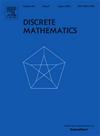Spectral extremal graphs for fan graphs
IF 0.7
3区 数学
Q2 MATHEMATICS
引用次数: 0
Abstract
A well-known result of Nosal states that a graph G with m edges and contains a triangle. Nikiforov [Combin. Probab. Comput. 11 (2002)] extended this result to cliques by showing that if , then G contains a copy of . Let be the graph obtained from a cycle by adding an edge to two vertices with distance two, and let be the friendship graph consisting of k triangles that share a common vertex. Recently, Zhai, Lin and Shu [European J. Combin. 95 (2021)], Sun, Li and Wei [Discrete Math. 346 (2023)], and Li, Lu and Peng [Discrete Math. 346 (2023)] proved that if and , then G contains a copy of and , respectively, unless . In this paper, we give a unified extension by showing that such a graph contains a copy of , where is the join of a vertex and a path on four vertices. Our result extends the aforementioned results since and are proper subgraphs of . In addition, we prove that if and , then G contains a copy of , unless . This confirms a conjecture on the friendship graph in the case . Finally, we conclude some spectral extremal graph problems concerning the large fan graphs and wheel graphs.
求助全文
约1分钟内获得全文
求助全文
来源期刊

Discrete Mathematics
数学-数学
CiteScore
1.50
自引率
12.50%
发文量
424
审稿时长
6 months
期刊介绍:
Discrete Mathematics provides a common forum for significant research in many areas of discrete mathematics and combinatorics. Among the fields covered by Discrete Mathematics are graph and hypergraph theory, enumeration, coding theory, block designs, the combinatorics of partially ordered sets, extremal set theory, matroid theory, algebraic combinatorics, discrete geometry, matrices, and discrete probability theory.
Items in the journal include research articles (Contributions or Notes, depending on length) and survey/expository articles (Perspectives). Efforts are made to process the submission of Notes (short articles) quickly. The Perspectives section features expository articles accessible to a broad audience that cast new light or present unifying points of view on well-known or insufficiently-known topics.
 求助内容:
求助内容: 应助结果提醒方式:
应助结果提醒方式:


